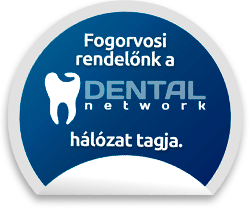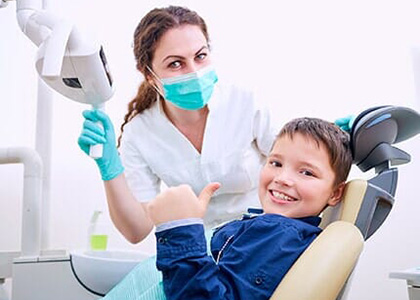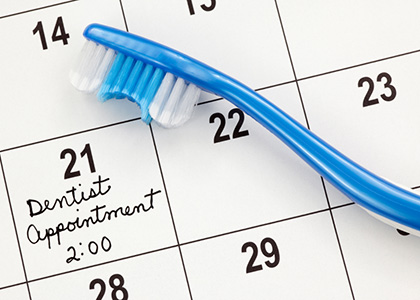Orthodontics for Children
Why is Orthodontics Important for Children?
Orthodontics is not just a matter of aesthetics but also a key to healthy oral development. In childhood, teeth and jawbones are still developing, making it an ideal time to correct bite disorders and dental irregularities. Orthodontics can help properly position the teeth, enhancing not only the beauty of the smile but also the functions of chewing, speech, and breathing. This section details why orthodontics is crucial during childhood and the benefits it offers to children.
Benefits of Orthodontics in Childhood
The benefits of orthodontics extend beyond aesthetics. Healthy teeth not only result in a beautiful smile but also contribute to the health of the oral cavity, proper chewing, speech, and breathing. Here are some important benefits that orthodontics offers children:
Corrected Bite: Bite disorders, such as overbite, underbite, or crossbite, can pose not only aesthetic issues but also functional disruptions. Orthodontic treatment can correct these disorders, preventing future dental problems like jaw joint pain, wear issues, and premature tooth wear.
Proper Alignment of Teeth: Orthodontics enables teeth to be positioned correctly, preventing crowding or abnormal growth. Crowded teeth are not only harder to clean but can also cause displacement of adjacent teeth, which may require further treatments in the long run.
Support for Speech Development: Incorrect positioning of teeth can often lead to speech defects, such as mispronunciation of certain sounds. Orthodontics can help correct these speech defects, thereby supporting a child's linguistic development and communication skills. Timely correction of speech problems is especially important for successful performance in school and social life.
Healthier Oral Cavity: Properly aligned teeth are easier to clean, reducing the risk of tooth decay and gum diseases. The health of the teeth and gums is closely linked, and proper orthodontic care can prevent problems that may arise from difficult-to-clean areas between the teeth.
Boosted Self-Confidence: A beautiful, straight set of teeth can enhance a child's self-confidence. Increased self-esteem positively affects their social relationships and overall well-being, as children feel better about their appearance. Boosting self-confidence is especially important during adolescence when peer opinions and appearance are particularly significant.
Long-Term Benefits of Orthodontics
Orthodontic treatment in childhood provides long-term benefits that manifest in all aspects of life. Timely orthodontic care not only preserves dental health but also prevents complications that might occur in adulthood.
Lasting Dental Health: Orthodontics helps prevent premature wear of the teeth, ensuring that the teeth remain healthy and functional for a long time. This is particularly important for maintaining lifelong dental health.
Prevention of Jaw Joint Issues: Incorrect bites and improper teeth alignment can lead to jaw joint issues over time, causing pain, clicking, and limited movement of the jaw. Orthodontics helps prevent these problems and ensures the health of the jaw joints.
Preservation of Overall Health: Oral health is directly linked to general health. Orthodontics can prevent issues like gum diseases, which have been associated with heart disease, diabetes, and other chronic conditions.
When is Orthodontics Necessary for Children?
The need for orthodontics is often determined by a child's dentist or an orthodontic specialist. The optimal period for children's orthodontic treatment generally falls between the ages of 7 and 14, but in certain cases, earlier intervention might be appropriate. Parents should watch for signs indicating that their child might need orthodontic treatment.
Signs for Orthodontics
Parents can often recognize the need for orthodontics based on the following signs:
Crowded or Rotated Teeth: If the teeth are crowded or improperly positioned, orthodontic treatment may be necessary. Crowding not only poses an aesthetic issue but also makes cleaning the teeth properly challenging, increasing the risk of tooth decay and gum diseases.
Open Bite: When a child smiles or chews, and there is a noticeable gap between the front teeth, this could be a sign of an open bite. An open bite can cause speech problems and negatively affect chewing and swallowing functions.
Difficulty Closing Lips: If a child's lips do not close together easily, it might be due to the position of the teeth. Difficulty in lip closure often indicates protruding teeth, which can be corrected with orthodontics.
Chewing or Speech Difficulties: Chewing or speech difficulties can also indicate the need for orthodontics. If a child is unable to chew food effectively or has speech impediments, consulting with an orthodontic specialist is advisable.
Early or Late Loss of Baby Teeth: Early or late loss of baby teeth can affect the growth of permanent teeth and may necessitate orthodontic treatment. Premature loss or retention of baby teeth can lead to displacement of permanent teeth, resulting in abnormal tooth alignment.
Timing is Crucial
The timing of orthodontic treatment is crucial for its success. Children's teeth and jaws are still in an active growth phase, allowing for effective correction with orthodontic appliances. Early intervention can prevent the development of more severe issues later and ensures healthy dental development.
Orthodontic specialists may recommend preventive treatment at an early age, especially if significant abnormalities are detected in the child's jaw or bite. These early treatments, known as interceptive orthodontics, can help minimize or completely prevent the need for more complex orthodontic procedures later.
Types of Orthodontics for Children
Several types of orthodontic appliances are available for children, from which an orthodontic specialist will choose the most suitable based on the child's individual needs. Here are the most common types of orthodontics:
Fixed Orthodontics
Fixed orthodontics is the most commonly used appliance in children's orthodontics. This type of appliance is permanently attached to the teeth and consists of metal or ceramic orthodontic wires and brackets.
Advantages: Fixed orthodontics exerts continuous pressure on the teeth, which provides more effective and quicker results. These devices allow for precise adjustments, which is especially important in complex cases. Additionally, they can be fun for the child, as there is the option to use colored bands.
Disadvantages: Since the orthodontic appliance is always on the teeth, it can be more difficult to maintain proper oral hygiene. Plaque can accumulate around the brackets and wires, increasing the risk of tooth decay and gum inflammation. Initially, the appliance may cause discomfort for the child as they get used to wearing it, and it can sometimes cause minor injuries to the lips and gums.
Removable Orthodontics
Removable orthodontic devices can be particularly useful in milder cases or when the child still has baby teeth. These orthodontics are easily removable and available in various types, such as night or daytime wear devices.
Advantages: Removable orthodontics allow the child to occasionally remove the appliance, for example, during meals or tooth brushing. This makes it easier to maintain oral hygiene, as the appliance is not constantly on the teeth. Removable devices are also often more comfortable, as the child can take breaks from wearing them.
Disadvantages: Since the removable orthodontic can be taken out by the child, there is a risk that they may not wear it for the necessary amount of time, which can reduce the effectiveness of the treatment. Removable devices may be less effective in treating more severe dental disorders, and the child's responsibility is critical for successful results.
Invisible Orthodontics (Invisalign)
Invisalign-type invisible orthodontics are becoming increasingly popular among children as well. This type of orthodontic, made of transparent plastic, is almost invisible on the teeth and removable, thus offering a comfortable and aesthetic solution.
Advantages: Invisalign orthodontics are almost invisible, which can be particularly appealing to children who may feel self-conscious wearing traditional braces. They are also removable, making it easier to maintain oral hygiene, and are often more comfortable than traditional braces as there are no brackets or wires that can irritate the inside of the mouth.
Disadvantages: Invisalign treatment is generally more expensive than traditional braces and is not applicable in every case. The removability also means that the wear time is critical to the success of the treatment, as the child must responsibly wear the aligners for 20-22 hours a day to achieve the desired result. Invisalign may not be the best choice for all dental problems, especially in cases of severe misalignments or bite disorders.
The Process of Orthodontics for Children
The process of orthodontic treatment involves several steps, which are tailored by the orthodontic specialist based on the child's individual needs and the condition of the teeth. The goal of the treatment is to ensure that the teeth and jaw are in optimal positions, securing healthy oral functions and an aesthetic appearance.
1. Initial Consultation
The first step in orthodontics is the initial consultation, during which the orthodontic specialist examines the child's teeth and jaw, assesses the condition and alignment of the teeth, and may take x-rays and impressions to precisely determine the necessary treatment.
During the initial consultation, the specialist discusses the child's dental issues and possible treatment options with the parents. This meeting also provides an opportunity for the parents and child to ask questions and better understand the treatment process and objectives.
2. Developing a Treatment Plan
Based on the results of the examinations, the orthodontic specialist will create a personalized treatment plan that considers the child's age, dental condition, and the alignment of the teeth. The plan includes the type of orthodontic device to be used, the duration of wear, and any additional interventions that may be needed, such as tooth extraction or bone grafting. The treatment plan will detail how the teeth will move, at what pace, and how often the child will need to return for check-ups. After discussing the treatment plan, both the parents and the child will understand what to expect during the treatment process.
3. Placing the Orthodontic Device
The next step is the placement of the orthodontic device, where the specialist carefully attaches the appliance to the teeth. This process is usually painless, but it may be uncomfortable for the child initially as they get used to wearing the orthodontic device. After placement, the specialist will provide instructions on how to care for the orthodontic device and what oral hygiene habits to develop during the treatment period.
4. Regular Check-Ups
During orthodontic treatment, regular check-ups are necessary. At these appointments, the orthodontic specialist monitors the movement of the teeth and makes adjustments to the device as needed. These check-ups usually occur every 4-6 weeks and are crucial for the success of the treatment. During these visits, the specialist fine-tunes the orthodontic device to ensure the teeth move correctly and achieve the desired result. Parents also play a critical role during these check-ups by monitoring their child's oral hygiene and ensuring that the child adheres to the prescribed treatment schedule. The specialist may provide additional advice on oral care and address any potential issues related to wearing the orthodontic device during these visits.
5. Removal of the Orthodontic Device
Once the teeth have reached the desired position, the orthodontic device is removed. After this, the child may receive a retention device to maintain the new position of the teeth and prevent regression. The retention device can be fixed or removable and is usually worn at night. The retention period is crucial because the teeth tend to shift back to their original position, especially shortly after the removal of the orthodontic device. The specialist will determine how long the retention device should be worn and will conduct regular check-ups to ensure the teeth remain stable.
How Can Parents Support the Orthodontic Treatment?
Parents play a vital role in supporting their child during orthodontic treatment. The following tips can help ensure the treatment is successful and smooth:
1. Motivation and Positive Attitude
Orthodontic treatment can be a lengthy process, so it is important for parents to maintain a positive attitude and support their child. Praise and recognition can help maintain the child's motivation, especially during the initial stages of treatment when wearing the orthodontic device may cause discomfort. The encouraging attitude and patience of parents can help the child persevere with the treatment and ultimately achieve the desired results.
2. Regular Oral Hygiene
Maintaining oral hygiene is critical during orthodontic treatment. Parents should assist their child in brushing properly, using dental floss, and employing mouthwash. Cleaning around the orthodontic device is particularly important as these areas are prone to plaque and tartar buildup. Neglecting proper oral care can lead to tooth decay and gum inflammation, and can jeopardize the success of the orthodontic treatment.
3. Ensuring Regular Check-Ups
Regular orthodontic check-ups are essential for the success of the treatment. Parents should ensure that their child attends all necessary appointments and regularly visits the orthodontic specialist. It is important not to miss these appointments as timely adjustments of the orthodontic devices ensure proper movement of the teeth and the achievement of the desired results.
4. Appropriate Diet
During orthodontic treatment, it is important for children to avoid hard, sticky, or sugary foods that can damage the orthodontic device or increase the risk of tooth decay. Parents can help their child develop a healthy diet that supports the health of the teeth and gums. It is advisable to avoid hard candies, nuts, and chewy sweets that can break brackets or damage wires.
5. Involving the Child in the Treatment
It is important for the child to understand the purpose and importance of orthodontic treatment. Parents can involve the child in decisions made during the treatment, such as choosing the color of the orthodontic device or deciding which appointment to attend. This can increase the child's commitment to the treatment and help them take an active part in their own dental care.
By following these guidelines, parents can play a supportive and active role in the success of their child's orthodontic treatment, helping to ensure a positive outcome and a healthy, beautiful smile for their child.





















